Late Umbrian and Early Latin Inscriptions


Introduction
(Numbers in square brackets in the headings refer to the entries in the catalogue of the exhibition ‘Screhto Est’ edited by L. Agostiniani et al., referenced below)
Assisi
Berkeley Villa Inscription (3rd century BC) [31]
Part of an architrave from a gate in the ancient city walls was discovered in 1938 near the ex-Oratorio di San Lorenzo and is still preserved in the garden of what became the Berkeley Villa. The architrave contains a fragmentary Umbrian inscription that uses an Etruscan alphabet. It has been transcribed:
estac vera papa...
mestiça vipies e...
The first line seems to confirm that the stone was part of a gate, while the second seems to mean “under the meddix Vibius E…”. The word “meddix” described a magistrate in the Oscan-speaking communities to the south of modern Umbria.
The garden of the Berkely Villa is not open to the public, but there is a plaster cast of this inscription in the Museo Civico, Assisi.
Cippus (2nd century BC) [43]
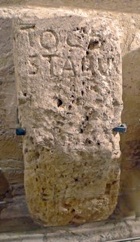
“toce stahu”,
which probably means "I stand in a public place".
The cippus is now in the Museo Civico, Assisi (Exhibit 1).
Umbrian Inscription (late 2nd century BC) [28]
This inscription, which was discovered in the convent of San Damiano in 1982, was embedded in the corner of the cloister below Monte Subasio during the restructuring of the complex in 2001. The inscription, in the Latin alphabet, reads:
ARENTEI O[...]
ASO SACR[...]
The inscription was originally thought to have been in Latin, but the word “aso” is now thought to be the Umbrian word for an altar. Simone Sisani (referenced below, 2007) translates it as:
altar sacred to Arentia O[.....]
where the “O” is an abbreviation of the unknown Umbrian word that equates to the Latin epithet “Obsequens” (as in “Venus Obsequens”, where the epithet is translated into English as compliant, gracious or accommodating). Arentia is otherwise unknown in Italy, but Arentius and his wife Arentia were worshipped in ancient Lusitania (modern Portugal).
Cippus from Bastia (ca. 100 BC) [45]
The cippus was found in 1742 at Ospedalicchio, near Bastia (between Assisi and Perugia). The inscription is one of the longest surviving inscriptions in the Umbrian language and also the oldest known example that uses the Latin alphabet. It reads:
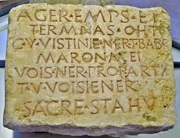
TERMNAS OHT[RETIE]
C V VISTINE NER T BABR[IE]
MARONATEI
VOIS NER PROPARTIE
T V VOISNIER
SACRE STAHU
The inscription refers to a field (ager) that has been bought and delimited (emps et termnas) during the period of office of:
-
✴the two men who held the post of uhter in the year in question:
-
•C(aius) Vestinius, son of V(ibius) and
-
•Ner(o) Babrius, son of T(itus); and
-
✴the two men who held the post of marone:
-
•Vois(ienus) Propartius, son of Ner(o); and
-
•T(itus) Voisienus, son of V(ibius).
The final words “sacre stahu” probably imply that the field had religious significance: it is suggestive that the flour used in the annual ritual described in Table Vb of the Iguvine Tables came from the Ager Tltius and the Ager Casilus of Picus Martius.
Nero Babrius, son of Titus appears in the more junior post of marone in the (presumably earlier) Latin inscription on the cistern at San Rufino, Assisi.
The cippus from Bastia is now in the Museo Archeologico Nazionale, Perugia, and there is a plaster cast of it in the Museo Civico, Assisi.
Bevagna/ Montefalco
Funerary Inscriptions
Three of the seven known funerary inscriptions in the Umbrian language come from Mevania. (The other four are from Todi - below - and, unlike those from Mevania, these use the Latin alphabet).
Inscribed sarcophagus cover from Bevagna (2nd century BC) [50]
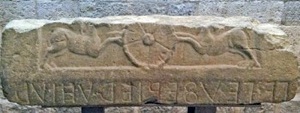
This fragment of a sarcophagus, which came from the area of Bevagna and which is now in the Museo Civico, Gubbio., is decorated with a relief of a wheel flanked by griffins. The inscription (ST Um 25) below uses an Etruscan alphabet:
Pe. Pe. Uferier Uhtur
It commemorates Petro Ofedius, son of Petro, who held the post of “uhter” (senior magistrate).
Inscribed cover of a cinerary urn (ca. 100 BC) [52]

This inscription ST Um 26) is on the cover of a cinerary urn, which was found in the area of the Fabbrica necropolis (see Walk II, Bevagna), and which is now in the the Museo Archeologico, Bevagna. The Umbrian inscription, which uses an Etruscan alphabet, reads:
vi(pi) ia kaltini
Vibio Caltinio, the son of Ianto
Funerary Inscription (ca. 100 BC) [51]
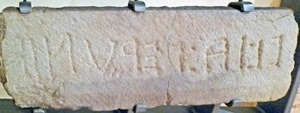
This inscription (ST Um 26) on the lid of a cinerary urn, which uses an Etruscan alphabet, was found recently in Vecciano, outside Montefalco. It reads from right to left:
vi: ia: perunia
Vibio Perunia, the son of Ianto
It is now in the Museo Civico, Montefalco.
Sundial from Bevagna (ca. 100 BC) [36]
This inscription (ST Um 8) is on a limestone sundial, which was ploughed up in 1969 near the tabernacle of the Madonna del Core, outside Porta Cannara (see Walk II, Detour B), Bevagna) and which is now in the Museo Archeologico Nazionale, Perugia.
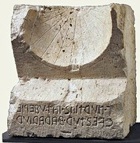
[-.] p. nurtins.ia.t.ufeřie[r]
cvestur farariur
[-] P. Nurtins [and] Ia. T. Uferier,
the quaestores of spelt [donated]
The surname of the first magistrate derives from the name of the Etruscan goddess, Nortia. The second transcribes into Latin as Iantus Aufidius, son of Titus. Their magistracy is probably analogous to that of “the two men who come to fetch the flour” for the sacrifice at the annual ritual described in Table Vb of the Iguvine Tables. It is possible that the triumphal way from Bevagna was used in similar rituals.
Inscribed cippi (1st century BC) [39-42]
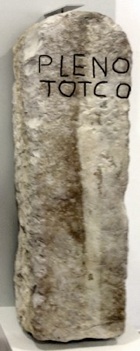
This is one of four essentially identical inscriptions came from different locations around Bevagna:
-
✴The second (CIL XI 5149a), which was found near the amphitheatre, no longer survives.
-
✴The third (EDR 159639), which was found near Sant’ Agostino, also no longer survives.
-
✴The fourth (AE 1965, 0279b), which is embedded in a house (8 Via Veronici) at Gualdo Cattaneo, was discovered there in 1965.
The stones probably marked the boundary of a public area, perhaps associated with the aqueduct or with the municipium itself.
Città di Castello
Aes Signatum (early 3rd century BC ) [57]
An “aes signatum” (inscribed bronze ingot) in the Staatliche Museen, Berlin , which was cast (probably in Rome) with a relief of a bull on each side, was later inscribed in Umbrian on one side:
“vukes sestines”
“of (or from) the vicus (village) [or, less probably, the lucus (wood)] of the Sestines”
The Sestines presumably lived on the site of the later municipium of Sestinum, modern Sestino, a town in the central Apennines, some 50 km north of Città di Castello.
The Romans produced ingots of this kind for monetary purposes in the period before the use of “aes grave” (cast bronze coins). The one described here belongs to a group characterised as “toro/toro”, because of the bull depicted on each side. These date to the first half of the 3rd century, and were probably used to pay allied soldiers for their service with the Roman army. The earliest record known of Umbrian solders fighting among the allies in the Roman army is from Dionysius of Halicarnassus and relates to the Battle of Asculum (279 BC).
The Berlin museum obtained the ingot described here from the collection of the renowned numismatist Ernst Justus Haeberlin (died 1925), who had bought it in 1907 and included it in his seminal book “Aes Grave: Das Schwergeld Roms und Mittelitaliens Einschließlich der ihm Vorausgehenden Rohbronzewährung” (1910). It had apparently been found by charcoal makers in a wood near Città di Castello in 1899. The most likely explanation is that it had been a votive offering made by the Sestines in a sanctuary here.
Foligno
Inscription from San Pietro di Flamignano (ca. 200 BC) [33]
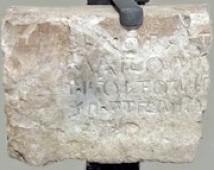
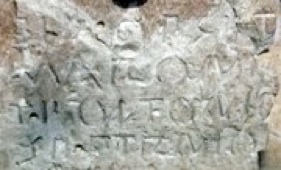
Detail
According to Chiara Lorenzini (referenced below, at p. 32), this inscription was:
-
“... found in 1928 in a field at Colle S. Pietro, between Trevi and Sant’ Eraclio, in the locality of San Pietro in Flamignano, along [the eastern branch of] Via Flaminia, about 2 km from a fountain known locally as ‘Petruio’” (my translation).
The text, which is in the Umbrian language and uses the Latin alphabet, reads:
bia . opset
marone
t . foltonio
se . ptrnio
The first line relates to the construction of something described as a ‘bia’ (probably a fountain) while the final two lines record the names of two marones (magistrates, whose office is still denominated in the Umbrian language): T(itus) Foltonius; and Se(xtus) Petronius. This suggests that these ‘marones’ had commissioned the ‘bia’, although it is alternatively possible that their names were recorded merely as a dating device, following Roman practice. Given the find spot of the inscription, we might reasonably assume that Titus Foltonius and Sextus Petronius were marones of Fulginia.
According to Simone Sisani (referenced below, 2007, pp. 381-2):
-
“[On the basis of paleographic analysis,] it is difficult to countenance a date later than [ca. 200 BC]: a “terminus circa quem” (approximate date) is furnished by the opening of Via Flaminia [in 220 BC], with which the building project mentioned in the inscription could have been connected” (my translation).
The fact that the inscription uses the Latin alphabet is consistent with this hypothesis, since the Via Flaminia would have been instrumental in the Romanisation of the territory through which it ran. However, the retention of the Umbrian words for the chief magistracy suggests that the inscription was not much later than the opening of the road.
The inscription is now in the Museo Archeologico, Palazzo Trinci, Foligno.
Inscription (ca. 200 BC) [38]
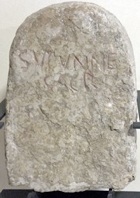
SUPUNNE
SACR
It is not clear whether the language is Umbrian or Latin, but it is likely that that the cippus marked the boundary of an area that was sacred to an otherwise unknown goddess, Supunna. Maria Romana Picuti (referenced below, at p. 134) reproduced the early records of this inscription and the two main hypotheses relating to the identity of Supunna:
-
✴Alberto Calderini (referenced below, at p. 63) revived the traditional hypothesis that she was a river goddess (since ‘Supunna’ might associated with the ‘Tupino’, the Topino river of Foligno); this would be similar to the case of Clitumnus, a god associated with the nearby river of that name).
-
✴Paolo Vitelozzi (referenced below) referred to the hypothesis that the etymology suggested an old Latin verb “to throw”, which might indicate that Supanna was a goddess who presided over the preparation of food in the course of rituals of sacrifice.
The inscription is now in the Museo Archeologico, Palazzo Trinci, Foligno.
Gualdo Tadino (Fossato di Vico)
Inscribed bronze plaque (2nd century BC) [35]
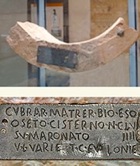
CVBRAR MATRER BIO ESO
OSETO CISTERNO N(ummi) CLV
IIII SV MARONATO
V L VARIE T C FVLONIE
Simone Sisani (referenced below, 2007, at p. 400, entry 96) dated it to the late 3rd century BC, but Giulio Giannecchini (in L. Agostiniani et al., referenced below, p. 51, entry 35) more recently dated it to the second half of the 2nd century BC.
Simone Sisani (referenced below, 2009, pp. 204-5, entry 26) observed that the inscription conveys two distinct pieces of information:
-
✴the first line can be translated as:
-
“this [is] the ‘bia’ [probably a fountain] of [the goddess] Cupra Mater”; and
-
✴the last three lines record that:
-
“[this] cistern was built at a cost of 159 nummi in the maronate (magistracy) of
-
•Vibius Varius, son of Lucius; and
-
•Titus Fullonius, son of Gaius.
Sisani suggested that:
-
✴the terracotta support to which the plaque is still fixed probably came from the rim of a round puteal that covered the opening of the cistern through which water was draw; and
-
✴the cistern was used to store water that had taken from the fountain of Cupra Mater, which was therefore sacred to the goddess.
In an earlier publication, Simoni Sisani (referenced below, 2007, at p. 400) reasonably suggested that the marones named in it been magistrates of nearby Tadinum, to which Helvillum had almost certainly belonged (as discussed above).
The goddess Cupra Mater is also known from four inscriptions (4th century BC) from a sanctuary that was excavated at Plestia (near modern Colfiorito). It also seems that she had a sanctuary at Helvillum: Francesco Marcattili (referenced below, at pp. 478-80 and Figure 16) described the excavations that were carried out in 1918 on a site adjacent to the find spot of the inscription, which revealed a rectangular sanctuary containing two large water basins. On the basis of his analysis of cult sites in Italy dedicated to Bona Dea, with whom the Umbrian Cupra has been identified, he observed that:
-
“[The fact] that the cult celebrated in the sanctuary of Cupra of Helvillum vicus was identical to that officiated for Bona Dea in Ostia (and elsewhere) is revealed without a shadow of doubt by the existence of two large open basins ... in the immediate vicinity of the [find spot of the inscription]. ... As is evident, we have here a coherent structural and functional system that satisfies the liturgical requirements ... that were common to the worship of both Bona Dea and Cupra” (my translation).
In other words, the bia at Aja della Croce seems to have been integral to a sanctuary dedicated to Cupra.
Gualdo Tadino
Inscription (ca. 200 BC) [26]
-
This fragment of part of the right edge of an inscribed bronze tablet was found in 2004 on the site of Roman Tadinum. According to Simone Sisani and Alberto Calderini (referenced below, p. 271 and Figure 1), it was found by local residents slightly to the north of the excavated area here. They speculated (at p. 275) that it might have come from a repository found nearby that contained several hundred metal objects dating from the 6th to the 2nd century BC. They also suggested that the fragment had been removed from the original bronze plaque using five separate cuts in order to arrive at a precise weight (8.6 grams).
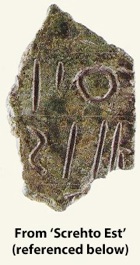
-
Nine letters in the Latin alphabet can be identified on the surviving fragment:
-
...]ofo
-
...]riei
-
...] ot[..]
According to Alberto Calderini (in L. Agostiniani et al., referenced below, p. 34, entry 26), the inscription is probably in the Umbrian language and, according to Sisani and Calderini (at p. 274), it dates to the late 3rd century BC.
Alberto Calderini summarised the analysis from the earlier paper that had identified a possible correspondence between the content of this fragment and two formulae used in the Iguvine Tables (below): Table Ib and Table VIIa both contained these formulae, both of which described the ritual sacrifice of three red or black pigs. He therefore hypothesised (at pp. 34-5) that this fragment from Tadinum was:
-
“... part of a bronze plaque that described a ritual mirroring the Iguvine sacrifice of ‘PORCA. TRIF. ROFA.’ (three red pigs) ...” (my translation).
He commented (at p. 35) that:
-
“This correspondence removes the [apparent] isolation of the Iguvine Tables, not just because [the fragment from Tadinum] represents a new tabula from Umbria but also in relation to the particular type of content. ... the provenance of [this fragment] is also important in this context: it comes from the closest centre to Iguvium, which was itself mentioned as the tota tarinate in the Iguvine Tables, and was found ... in the area of the Roman city [of Tadinum]” (my translation).
The surviving fragment is now in the deposit of the Soprintendenza per i Beni Archeologici dell'Umbria, Perugia. The photograph here is from entry 26 of ‘Screhto Est’.
Gubbio
Iguvine Tables (3rd - 1st centuries BC) [17]
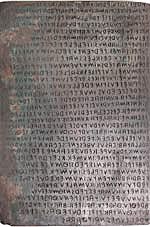
Copy of one of the Iguvine Tables
Image courtesy of the Soprintendenza per i Beni Archeologici dell' Umbria
These seven bronze tables, which contain what is by far the longest surviving inscription in an Italic language other than Latin, are described in the page “Iguvine Tables”. The tables are now in Museo Civico, Gubbio, and the text of the inscriptions is published as part of the Titus Project.
Nocera Umbra
Inscribed bronze helmet (3rd century BC) [58]
This helmet was found in a Gallic burial in Bologna in 1881. It contains an inscription that uses an Etruscan alphabet and reads:
...areh nuvkri
This might record the name of a soldier from Nuceria, modern Nocera Umbra, who could have lost it fighting against the Gauls in 225-4 BC. The helmet is now in the Museo Civico Archeologico, Bologna.
Spello
Inscription (3rd century BC) [34]
This inscribed stone was used in 1956 on the inside of the right upright of the gate of Palazzo Preziosi (26 Via Belvedere). It reads “[...]flam[...]”, and could refer to Via Flaminia.
Perfume Flask (ca. 200 BC) [60]
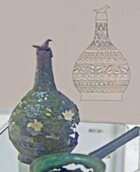
num [i]u
perhaps “Numisius Iunius”
The flask is now is in now the Civic Archeological collection in Palazzo Bianconi, Spello.
Jupiter (3rd century BC ?) [27]
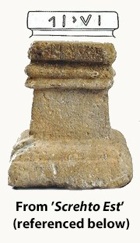
iuvip(atre)
This probably refers to the god Jove the Father, or Jupiter. [Is it exhibited at the Museo Archeologico at Perugia ??]. The photograph here is from entry 27 of ‘Screhto Est’.
There is some uncertainty about the date of the inscription:
-
✴Alberto Calderini (in L. Agostiniani, referenced below, entry 27) dated the alphabet used in it to the period between the mid 3rd century and the early 2nd century BC, although he conceded that there was some uncertainty.
-
✴Simone Sisani (referenced below, 2012, at p. 424 and note 86) regarded this as too late, and alternatively dated it to the 4th or 3rd century BC.
Dorica Manconi (also in Entry 27) asserted that the altar almost certainly supported a small bronze votive offering to the god, which suggests the presence of a temple of this dedication nearby. Simone Sisani (referenced below, 2002, at p. 499) suggested that the whole sanctuary might initially have been dedicated to ‘iuvipatre’, who represented:
-
“... a perfect parallel to Tinia [Tinia Velθumna], venerated at the [Etruscan sanctuary of] fanum Voltumnae at Volsinii ... the probable model for the Umbrian sanctuary [at Hispellum]” (my translation).
Terni
Inscription (early 3rd century BC) [29]
This inscription is on a monumental travertine block that was found in front of the entrance to Temple A, one of two temples excavated in the sanctuary at the summit of Monte Torre Maggiore. It uses an Etruscan alphabet and probably dates to the period in which the sanctuary was first monumentalised. The damaged inscription reads (approximately):
.....]e[.....
......]ri . f. i . atri[.....
...]. t . rufrie
This probably gives the name of a magistrate and the name of his office. The inscription is now in the deposit of the Soprintendenza per i Beni Archeologici dell'Umbria, Perugia.
Grafitti (early 2nd century BC) [63]
This inscription, which is scratched onto a piece of pottery from Temple A on Monte Torre Maggiore, reads:
...] . pupun[
This is presumably part of the name of the person to whom the pottery object belonged. The fragment is in the Museo Archeologico, Terni.
Todi
Grave Markers (late 2nd century BC) [46-9]
The earliest surviving Umbrian inscriptions (ST Um 27-30) that use the Latin alphabet are on set of tiles that sealed grave niches, which were found in ca. 1700 outside Todi. These represent four of only seven known funerary inscriptions in the Umbrian language. (The other three are from Bevagna - above). Note that Simoni Sisani (referenced below, 2007, at p. 287, note 52) suggested that these did not belong in the corpus of Umbrian inscriptions.)
The inscriptions from Todi commemorate members of three generations of the same family:
la ma tuplei;
tupleia pu plece;
ma puplece; and
ca puple cema fel.
-
✴The oldest of these inscriptions, which uses an Etruscan alphabet, commemorates “la ma tuplei” (Lars Dupleius, son of Marcus).
-
✴The next two inscriptions, which use the Latin alphabet, commemorate:
-
•his daughter, “tupleia pu plece” (Dupleia Publicii), who takes her name from her father and her husband (see below); and
-
•her husband, “ma puplece” (Marcus Publicius).
-
✴The fourth, which use the Latin alphabet, commemorates their son, “ca puple cema fel” (Caius Publicus, son of Marcus).
In the first case, the name order reflects Umbrian practice: the name of Lars’ father comes before their cognomen. However, in the last case, Caius Publicus uses the Roman order: his name and cognomen followed by the name of his father. “Fel”, which has the same meaning as “f[ilius]” in a Latin name, could be either an authentic Umbrian word or a loan word from Latin.
These tiles are now in the Museo Oliveriano, Pesaro.
Inscribed dish (ca. 100 BC) [71]
The provenance of this fragment of a dish is unknown. The inscription on its outer surface, which uses an Etruscan alphabet, reads “vibie” and is probably part of a name. The fragment is now in the Museo Civico, Todi.
Latin
Spoleto
Cippi of the Lex Spoletina (ca. 240 BC) [75]
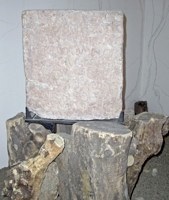
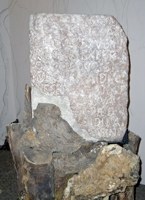
These two archaic Latin inscriptions (CIL XI 4766), which were found about 10 km west of the Fonti del Clitunno, bear nearly identical texts:
Honce loucom/ ne qu<i>s uiolatod/ neque exuehito neque
exferto quod louci/ siet neque cedito/ nesei quo die res deina
anua fiet eod die/ quod rei dinai cau[s]a/ [f]iat, sine dolo cedre
[l]icetod, seiquis/ uiolasit Ioue bouid/ piaclum datod
si quis scies/ uiolasit dolo malo/ Iouei bouid piaclum
datod et a(sses) CCC/ moltai suntod
eius piacli/ moltaique dicator[ei]/ exactio est[od]
Michael Gilleland has posted on line two English translations, one of which is as follows:
-
“Let no-one violate this grove nor carry out anything that is in the grove nor set foot in it [or possibly 'cut it'] except annually on the day of the rite; on the day when it is done because of the rite, it shall be permitted to enter (cut) it with impunity. Whosoever violates the grove shall give a purificatory offering of an ox to Jupiter; whoever violates it knowingly and maliciously shall give a purificatory offering of an ox to Jupiter and shall be fined 300 asses [a unit of currency]. The dicator (chief magistrate) shall be responsible for the exaction of the offering and fine”.
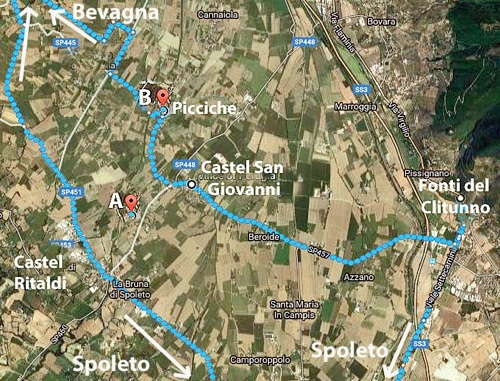
The inscription are of great interest in relation to both archaic Latin script and to Roman law. They clearly relate to a wood or grove that was sacred to Jupiter that was presumably located in the area in which the cippi were found. In fact, Giuseppe Sordini found them on two separate occasions and in two separate locations:
-
✴Inscription A was found in 1879 on Colle di San Quirico, between Castel San Giovanni and Castel Ritaldi; and
-
✴Inscription B was found in 1913, embedded in the facade of the church of Santo Stefano in Picciche.
Simone Sisani (referenced below, 2012, p. 420) pointed out that Picciche was on a side road off the main Mevania-Spoletium road that crossed the Valle Umbra towards the Fonti del Clitunno. He suggested that:
-
“It is likely that [Inscription B] was originally beside this road, alerting travellers to the fact that they were entering an area that was subject to specific religious constraints; [Inscription A] must have had an analogous function, and its find spot near Castel Ritaldi lends credence to the hypothesis that it was beside the main Mevania-Spoletium. road” (my translation)
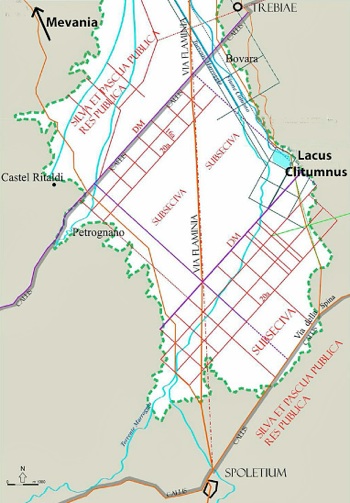
Pertica of Spoletium
Adapted from Camerieri and Manconi (referenced below, Figure 3)
According to Luca Donnini (in ‘Screhto Est’, referenced below, entry 75):
-
“Regarding the chronology of the two cippi, based on the script and the language, it certainly seems that both can be securely dated to the years immediately following the deduction of the Latin colony of Spoletium in 241 BC, ...” (my translation)
Paolo Camerieri and Dorica Manconi (referenced below) established the extent of the territory assigned to the colony at this point, as illustrated above: the sacred grove northeast of Castel Ritaldi would have occupied part of the area of public land used for woods and pasture (silva et pascua) across the northwest area of the pertica. (The northern part of this territory (including the Fonti del Clitunno) had probably belonged to Mevania before colonisation.)
Simone Sisani (referenced below, at p. 416) suggested that the grove was sacred to Clitumnus/Jupiter and that the grove might well have extended as far as the sanctuary dedicated to him at the Fonti del Clitunno:
-
✴Vibius Sequester recorded that:
-
“Clitumnus Umbriae, ubi Iuppiter eodem nomine est” (‘De fluminibus’).
-
Thus it seems that the river god Clitumnus was, in some sense, a manifestation of Jupiter.
-
✴Propertius, speaking of the god Clitumnus, referred to the Clitumnus river as “his wave” and reported that it was covered (or perhaps shrouded) by “his own woods”.
-
✴Suetonius recorded a visit by the Emperor Caligula to the “river Clitumnus and its nemus (sacred grove)”.
There is a copy of one of the cippi in the woods on Monteluco (see Walk IV), probably because the name of the mountain derives from the Latin “lucus” (sacred grove).
Trevi
Stele of Bovara (late 3rd century BC) [76]
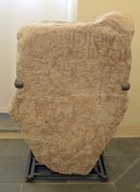
The two-line inscription, written in Latin using an archaic Latin alphabet, cannot be fully deciphered:
------- / [---] Atiete en/ [-]laga dedre
The word Atiete is recognisable and known from the Ikuvine Tablets: it means a college of priests.
The location in which the inscription was found is only about 5 km from Picciche and 10 km from Castel Ritaldi, the places in which the cippi inscribed with the Lex Spoletina (above) were found. These two inscriptions were also inscribed in archaic Latin, and it seems likely that all three were associated with the nearby Roman colony at Spoletium.
Amelia
Inscription from San Secondo (2nd century BC)
This inscription (CIL XI 4348) recorded that Titus Pettius, son of Titus, grandson of Titus had made a gift to “Iove Optumo Maxsumo” (Jove Optimus Maximus, the supreme god of the Roman pantheon). The archaic language suggests that the inscription dates to the middle of the 2nd century BC, which is early for the use of Latin in Umbria and for the veneration of Jove Optimus Maximus there. The inscription, which has unfortunately been lost, was documented in San Secondo in a sketch (1564) by the sculptor and antiquarian Giovanni Antonio Dosio that survives in the Staatsbibliothek, Berlin. Guy Bradley (referenced below, at p. 294) dated it to ca. 150 BC.
Assisi
Inscription from San Rufino (2nd century BC) [77]
This is a cast of an inscription (CIL XI 5390) is over an arch that leads to a Roman cistern that now forms the foundation for the campanile of San Rufino, Assisi. It is one of the earliest in Latin to survive in an Umbrian city. It names six marones:
-
✴Post(umus) Mimesius, son of C(aius);
-
✴T(itus) Mimesius, son of Sert(orius);
-
✴Ner(o) Capidas Rufus, son of C(aius);
-
✴Ner(o) Babrius, son of T(itus);
-
✴C(aius) Capidas, son of T(itus), grandson of C(aius); and
-
✴V(ibius) Volsienus, son of T(itus).
Nero Babrius, son of Titus had the more senior post of uhter in the Umbrian inscription on the cippus from Bastia (see Exhibit 2 above), which is therefore probably of a slightly later date. This demonstrates that both Latin and Umbrian were used in public inscriptions in the late 2nd and early 1st centuries BC.
The rest of the inscription reads:
murum ab fornice ad circum et fornicem cisternamq(ue)
d(e) s(entaus) s(ententia) faciundum coiravere
This records the building (by order of the municipal senate) of the terrace wall that can be seen running under the left side of San Rufino, which apparently originally extended from the arch (fornix) of the cistern to another arch near the circus (which was in modern Piazza Matteotti).
Nero Babrius, son of Titus appears in the more senior post of uhter in the (presumably later) Umbrian inscription on the cippus from Bastia.
Only the left part of it is now visible in situ, but there is a cast of it in the Museo Civico, Assisi.
Inscription from S Maria Maggiore (ca. 100 BC)

"Iter precar(ium)"
This seems to indicate that passage was granted by prayer or on request.
There is a cast of it in the Museo Civico, Assisi.
Bevagna
Lid of a cinerary urn (late 2nd century BC)

C(aius) Laaro V(ibii) f(ilius) T(iti) n(epos)
Caius Laaro, son of Vibius, grandson of Titus
The urn, which is from an unknown location in Bevagna, is now embedded in the wall of the Museo della Città.
Bevagna and Otricoli
Popilius Cups (2nd and 1st centuries BC) [80-1]
The so-called Popilius cups, which were inscribed with the Latin name of Caius Popilius (CIL XI 6704, 3), were made in Mevania and Ocriculum and were widely spread throughout Etruria. It seems likely that Caius Popilius was a Latin-speaking migrant who was attracted by the clay deposits at Mevania and by the transport links offered by Via Flaminia and by the port on the Tiber at Ocriculum. Two examples are illustrated in the catalogue below:
-
✴One from Cerveteri [80], which is now in the Museo Nazionale Etrusco di Villa Giulia, Rome, has the inscription:
-
C POPILI/ OCRICLO
-
✴One from Corchiano (near Viterbo) [81], which is now in the Museum of Fine Arts, Boston (95.59), has the inscription:
-
C POPILI/ MEUANIE
Other Popilius signatures are illustrated in the article by André Baudrillart (referenced below).
Massa Martana
Inscribed funerary stele (late 2nd century BC)
This extraordinary epitaph was found in 1839 in the area of the Vicus Martis Tudertium, near Massa Martana. There are almost identical bilingual inscriptions on each side of the stone: these are given in Latin and in Gallic (using an Etruscan alphabet). This stele is in the Museo Vaticano, Rome and the inscriptions are illustrated in the website of L’ Arbre Celtique.
-
The Latin inscription, which is the fuller of the two, reads:
[ATEGNATI] [DRVT]I[.] F[...]
[C]OISIS [.] DRVTI F
[F]RATER EIVS [M]INIMIS LOCAVIT [ST]ATVITQV[E]
The tomb of Ategnatus, son of Drutos,
Coisis, son of Drutos,
his younger brother placed and set up
-
The shorter, Gallic inscriptions read:
ATTEKNATI TRUTIKNI KARNITU ARTUAS KOISIS TRUTIKNOS
Coisis son of Drutios has erected the tomb of Ategnatos, son of Drutios
This is the earliest Latin inscription found in the vicinity of Todi. The names indicate that this family was of Gallic descent, and it is interesting to note that Ahal Trutitis, the donor of the so-called Mars of Todi (late 5th century BC), seems to have been of Gallic descent.
Perugia, from Bettona
Funerary Inscription (late 2nd century BC) [79]

[-] UOISIUS L F [...]
AUIANIA[...]
[?] Voisius, son of Lucius and Aviania.
The name seems to retain the Etruscan formula, in which Avania’s name is apparently not preceded by the Latin “gnatus” (born of). It is now displayed with other grave goods from the hypogeum in the Museo Archeologico, Perugia .
Read more:
F. Marcattili , “Tra Venere, Bona Dea e Cupra: Note a Margine della Lamina di Fossato di Vico”, in:
A. Ancillotti et al. (Eds), “Forme e Strutture Della Religione nell' Italia Mediana Antica: Atti Del Terzo Convegno Internazionale Di Studi Umbri: 21-25 Settembre 2011”, (2016) Rome
M. Romana Picuti, “Tra Epigrafia e Antiquaria: le Iscrizioni di Supunna e delle Cultrices Collegi Fulginiae nel De Diis topicis Fulginatium di Giacomo Biancani Tazzi”, in:
E. Laureti (Ed.), “G. Biancani: De Diis Topicis Fulginatium Epistola, Foligno 1761”, (2014 ) Spello, pp. 129-43
L. Agostiniani et al. (Eds), “Screhto Est: Lingua e Scrittura degli Antichi Umbri”, (2011) Città di Castello
S. Sisani, “Umbrorum Gens Antiquissima Italiae: Studi sulla Società e le Istituzioni dell' Umbria Preromana”, (2009) Perugia
L. Sensi (Ed.), “Discorso di Fabio Pontano sopra l’ Antichità della Città di Foligno”, (2008)
S. Sisani, “Fenomenologia della Conquista: La Romanizzazione dell' Umbria tra il IV sec. a. C. e la Guerra Sociale”, (2007) Rome
S. Sisani and A. Calderini, “Frammento di Tavola Bronzea da Gualdo Tadino”, Studi Etruschi, 72 (2006) 271-8.
S. Sisani, “Lucius Falius Tinia: Primo Quattuorviro del Municipio di Hispellum”, Athenaeum, 90.2 (2002) 483-505
A. Calderini, “Iscrizione Umbre”, in”
M. Matteini Chiari (Ed.), “Raccolte Comunali di Assisi: Materiali Archeologici; Iscrizioni; Sculture; Pitture; Elementi Architettonici”, (2005) Perugia, pp. 51-78
G. Bradley, "Ancient Umbria", (2000) Oxford, particularly Appendix II
C. Lorenzini, “Iscrizione dei Marones da San Pietro in Flamignano”, in:
“Fulginates e Plestini: Popolazioni Antiche nel Territorio di Foligno: Mostra Archeologica”, (1999) Foligno
G. Rocca, "Iscrizioni Umbre Minori", Florence (1996)
S. Sisani, “I Rapporti tra Mevania e Hispellum nel Quadro del Paesaggio Sacro della Valle Umbra”, in
G. Della Fina (Ed.), “Il Fanum Voltumnae e i Santuari Comunitari dell’ Italia Antica”, (2012) Orvieto, pp 409-63
L. Agostiniani et al. (Eds), “Screhto Est: Lingua e Scrittura degli Antichi Umbri”, (2011) Città di Castello
P. Cameriere and D. Manconi, “Le Centuriazioni della Valle Umbra da Spoleto a Perugia”, Bollettino di Archeolgic Online, (2010) 15-39
G. Bradley, "Ancient Umbria", (2000) Oxford
A. Baudrillart, “Coupes Signées de Popilius”, Mélanges de l' École Française de Rome, 9 (1889) 288-98
Umbria before the Social Wars: Main page
Umbrian Magistracies Via Amerina Via Flaminia Second Punic War
Umbrian Inscriptions Etruscan Inscriptions Latin Inscriptions
Return to the History Index

